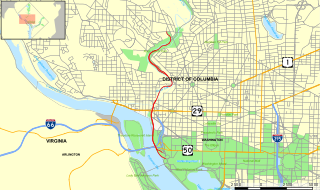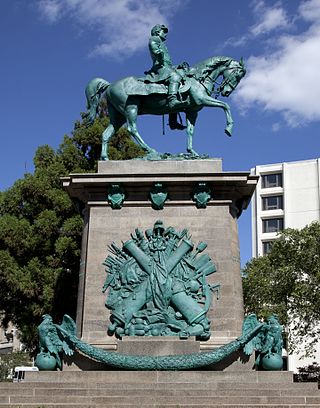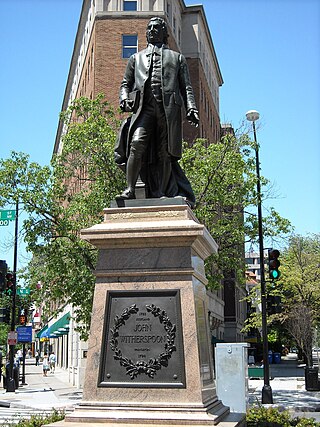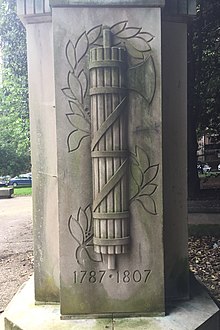
The National Mall is a landscaped park near the downtown area of Washington, D.C., the capital city of the United States. It contains and borders a number of museums of the Smithsonian Institution, art galleries, cultural institutions, and various memorials, sculptures, and statues. It is administered by the National Park Service (NPS) of the United States Department of the Interior as part of the National Mall and Memorial Parks unit of the National Park System. The park receives approximately 24 million visitors each year.

John Peter Gabriel Muhlenberg was an American clergyman and military officer who served during the American Revolutionary War. A member of Pennsylvania's prominent Muhlenberg family political dynasty, he became a respected figure in the newly independent United States as a Lutheran minister and member of the United States House of Representatives and United States Senate.

Dupont Circle is a historic roundabout park and neighborhood of Washington, D.C., located in Northwest D.C. The Dupont Circle neighborhood is bounded approximately by 16th Street NW to the east, 22nd Street NW to the west, M Street NW to the south, and Florida Avenue NW to the north. Much of the neighborhood is listed on the National Register of Historic Places. However, the local government Advisory Neighborhood Commission and the Dupont Circle Historic District have slightly different boundaries.

Logan Circle is a historic roundabout park and neighborhood of Washington, D.C., located in Northwest D.C. The majority of Logan Circle is primarily residential, except for the highly-commercialized 14th Street corridor that passes through the western part of the neighborhood. In the 21st century, Logan Circle has been the focus of urban redevelopment and become one of Washington's most expensive neighborhoods. Today, Logan Circle is also one of D.C.'s most prominent gay neighborhoods.

Forest Hills is a residential neighborhood in the northwest quadrant of Washington, D.C., United States, bounded by Connecticut Avenue NW to the west, Rock Creek Park to the east, Chevy Chase to the north, and Tilden Street NW to the south. The neighborhood is frequently referred to as Van Ness because it is served by the Van Ness–UDC station on the Washington Metro's Red Line and is near the Van Ness campus of the University of the District of Columbia (UDC).

The Rock Creek and Potomac Parkway, informally called the Rock Creek Parkway, is a parkway maintained by the National Park Service as part of Rock Creek Park in Washington, D.C. It runs next to the Potomac River and Rock Creek in a generally north–south direction, carrying four lanes of traffic from the Lincoln Memorial and Arlington Memorial Bridge north to a junction with Beach Drive near Connecticut Avenue at Calvert Street, N.W., just south of the National Zoological Park.

Paul Philippe Cret was a French-born Philadelphian architect and industrial designer. For more than thirty years, he taught at a design studio in the Department of Architecture at the University of Pennsylvania.

There are many outdoor sculptures in Washington, D.C. In addition to the capital's most famous monuments and memorials, many figures recognized as national heroes have been posthumously awarded with his or her own statue in a park or public square. Some figures appear on several statues: Abraham Lincoln, for example, has at least three likenesses, including those at the Lincoln Memorial, in Lincoln Park, and the old Superior Court of the District of Columbia. A number of international figures, such as Mohandas Gandhi, have also been immortalized with statues. The Statue of Freedom is a 19½-foot tall allegorical statue that rests atop the United States Capitol dome.
National Mall and Memorial Parks is an administrative unit of the National Park Service (NPS) encompassing many national memorials and other areas in Washington, D.C. Federally owned and administered parks in the capital area date back to 1790, some of the oldest in the United States. In 1933, they were transferred to the control of the National Park Service. These parks were known as the National Capital Parks from their inception until 1965. The NPS now operates multiple park groupings in the D.C. area, including National Capital Parks-East, Rock Creek Park, President's Park, and George Washington Memorial Parkway. National Mall and Memorial Parks also provides technical assistance for the United States Navy Memorial.

Thomas Circle is a traffic circle in Northwest Washington, D.C., United States. It is located at the intersection of 14th Street, M Street, Massachusetts Avenue, and Vermont Avenue NW. A portion of Massachusetts Avenue travels through a tunnel underneath the circle. The interior of the circle includes the equestrian statue of George Henry Thomas, a Union Army general in the Civil War.
A series of Statues of the Liberators of western-hemisphere countries from colonial rule is found along Virginia Avenue, N.W., in Washington, D.C..

The Luther Monument is a public artwork located in front of Luther Place Memorial Church in Washington, D.C., United States. The monument to Martin Luther, the theologian and Protestant Reformer, is a bronze, full-length portrait. It is a copy of the statue created by Ernst Friedrich August Rietschel as part of the 1868 Luther Monument in Worms, Germany. The version in Washington, D.C., inspired the installation of many other castings across the U.S. The statue is a contributing property to the Luther Place Memorial Church's listing on the National Register of Historic Places (NRHP) and District of Columbia Inventory of Historic Sites (DCIHS). It is also a contributing property to the Greater Fourteenth Street Historic District, which is also listed on the NRHP and DCIHS.

Major General George B. McClellan is an equestrian statue in Washington, D.C. that honors politician and Civil War general George B. McClellan. The monument is sited on a prominent location in the Kalorama Triangle neighborhood due to efforts made by area residents. The statue was sculpted by American artist Frederick William MacMonnies, a graduate of the École des Beaux-Arts whose best known work is a statue of Nathan Hale in New York City. MacMonnies was chosen to design the statue following a lengthy competition organized by a statue commission, led by then Secretary of War William Howard Taft. The monument was dedicated in 1907, with prominent attendees at the ceremony including President Theodore Roosevelt, New York City mayor George B. McClellan Jr., politicians, generals and thousands of military personnel.

Brevet Lt. General Winfield Scott is an equestrian statue in Washington, D.C., that honors career military officer Winfield Scott. The monument stands in the center of Scott Circle, a traffic circle and small park at the convergence of 16th Street, Massachusetts Avenue and Rhode Island Avenue NW. The statue was sculpted by Henry Kirke Brown, whose best-known works include statues of George Washington in New York and Nathanael Greene in Washington, D.C. It was the first of many sculptures honoring Civil War generals that were installed in Washington, D.C.'s traffic circles and squares and was the second statue in the city to honor Scott.

The Dupont Circle Fountain, formally known as the Rear Admiral Samuel Francis Dupont Memorial Fountain, is a fountain located in the center of Dupont Circle in Washington, D.C. It honors Rear Admiral Samuel Francis Du Pont, a prominent American naval officer and member of the Du Pont family. The fountain replaced a statue of Du Pont that was installed in 1884. Designed by Henry Bacon and sculpted by Daniel Chester French, the fountain was dedicated in 1921. Prominent guests at the dedication ceremony included First Lady Florence Harding, Secretary of War John W. Weeks and Secretary of the Navy Edwin Denby.

The statue of John Aaron Rawlins, a United States Army general who served during the Civil War and later as Secretary of War, is a focal point of Rawlins Park, a small public park in Washington, D.C.'s Foggy Bottom neighborhood. It was installed in 1874, but relocated several times between 1880 and 1931. The statue was sculpted by French-American artist Joseph A. Bailly, whose best known work is the statue of George Washington in front of Independence Hall in Philadelphia.

Doctor John Witherspoon is a bronze sculpture and granite pedestal which depicts John Witherspoon, a Presbyterian minister, member of Congress, and signer of the Declaration of Independence. Born in Scotland, Witherspoon immigrated to the U.S. in the 1760s and later became president of the College of New Jersey. He strongly supported the Thirteen Colonies in their fight to obtain freedom from the United Kingdom of Great Britain and Ireland.
Columbian Harmony Cemetery was an African-American cemetery that formerly existed at 9th Street NE and Rhode Island Avenue NE in Washington, D.C., in the United States. Constructed in 1859, it was the successor to the smaller Harmoneon Cemetery in downtown Washington. All graves in the cemetery were moved to National Harmony Memorial Park in Landover, Maryland, in 1959. The cemetery site was sold to developers, and a portion used for the Rhode Island Avenue – Brentwood Washington Metro station.

St. Paul's Lutheran Church is a decorated Gothic Revival-style Lutheran church in northwest Washington, D.C. Currently located off of Connecticut Avenue NW, between Ellicott and Everett Streets, it was originally founded in 1843 as the first English-speaking Lutheran church in the District. St. Paul's is affiliated with the Evangelical Lutheran Church in America.






















